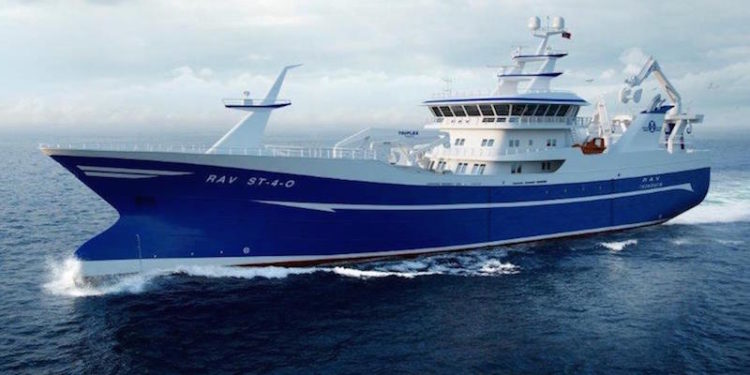The first Wärtsilä 31 engine to be installed in a fishing vessel is going to Norwegian company Peter Hepsø Rederi’s new purser/trawler which is to be built at Karstensens Skibsværft in Denmark.
Reputed to be the most efficient four-stroke engine in existence, the Wärtsilä 31 engine is to be fitted to the new Rav. Wärtsilä is supplying a full package of propulsion equipment, including a two-step gearbox, controllable pitch propellers, the nozzle, shaft generator and the Wärtsilä Propulsion Control System.
‘Our company will be celebrating its hundred year anniversary in 2017. It is appropriate that we mark the occasion with a new vessel that will represent the future of the fishing fleet. Wärtsilä’s propulsion solution provides the efficiency and environmental sustainability we needed for the ship,’ commented Peter Hepsø Rederi’s general manager Audhild Hepsø.
The Wärtsilä 31 engine is available in diesel, dual-fuel (DF) and spark-ignited Gas (SG) versions. The multi-fuel capabilities that the Wärtsilä 31 brings to the market extend the possibilities for operators to utilise different qualities of fuels, from very light to very heavy diesel, and a range of different qualities of gas. The engine is designed to serve a variety of vessel types requiring main engine propulsion in the 4.2 to 9.8mW power range. The remarkable increases in fuel efficiency and fuel flexibility that the Wärtsilä 31 brings to the market are matched by significant reductions in maintenance costs. For example, the first service on the Wärtsilä 31 is required after only 8000 running hours, whereas alternative standard marine engines require maintenance after 2000 running hours.
‘The Wärtsilä 31 engine has established a new benchmark in terms of fuel efficiency, which means also that its overall emissions performance is excellent,’ said Aaron Bresnahan, VP sales at Wärtsilä Marine Solutions. ‘Furthermore, the Wärtsilä 2-speed gearbox provides additional fuel savings and lower noise levels. We are very pleased to be working with the yard and owners in this project to introduce a world class trawler to the market.’.
He commented that compared to a single mechanical propulsion system, a fuel consumption reduction of 8% was verified with the Wärtsilä 2-speed gearbox during sea trials. It is anticipated that further reductions of up to 15% can be achieved, with a similar reductions in nitrogen oxide (NOx) and sulphur oxide (SOx) exhaust emissions.
‘These fuel cost savings and subsequent environmental benefits are achieved when maximum vessel speed or propeller thrust is not required,’ he said, explaining that when running the propeller at a reduced and more efficient speed closer to its design pitch, less power is required. At the same time, the engine speed is kept constant, thereby allowing the electric power generation from the gearbox PTO to remain constant and also uninterrupted when switching between the two gear steps.
‘Furthermore, by reducing the propeller speed there is a significant reduction in the underwater radiated noise level. This is of great importance for fishing- and seismic vessels and beneficial to marine life in general, while it is also highly appreciated by the crew due to less noise and vibration in the living quarters of the vessel.’









